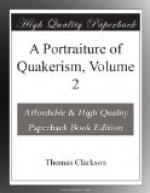That Christ, in all the offices stated by the proposition, is neither more nor less than the spirit of God, there can surely be no doubt. In looking at Christ, we are generally apt to view him with carnal eyes. We can seldom divest ourselves of the idea of a body belonging to him, though this was confessedly human, and can seldom consider him as a pure principle or fountain of divine life and light to men. And yet it is obvious, that we must view him in this light in the present case; for if he was at the creation of the world, or with Moses at the delivery of the law, (which the proposition supposes) he could not have been there in his carnal body; because this was not produced till centuries afterwards by the virgin Mary. In this abstracted light, the Apostles frequently view Christ themselves. Thus St. Paul:[102] “I live, yet not I, but Christ liveth in me.” And again,[103] “Know ye not your own selves, how that Jesus Christ is in you, except ye be reprobates?”
[Footnote 102: Gal. 2.20.]
[Footnote 103: 2 Cor. 15.5].
Now no person imagines that St. Paul had any idea, either that the body of Christ was in himself, or in others, on the occasions on which he has thus spoken.
That Christ therefore, as he held the offices contained in the proposition, was the spirit of God, we may pronounce from various views, which we may take of him, all of which seem to lead us to the same conclusion.
And first let us look at Christ in the scriptural light in which he has been held forth to us in the fourth section of the seventh chapter, where I have explained the particular notions of the Quakers relative to the new birth.
God maybe considered here as having produced, by means of his Holy Spirit, a birth of divine life in the soul of the “body which had been prepared;” and this birth was Christ. [104] “But that which is born of the spirit, says St. John, is spirit.” The only question then will be as to the magnitude of the spirit thus produced. In answer to this St. John says,[105] “that God gave him not the spirit by measure.” And St. Paul says the same thing: [106] “For in him all the fulness of the godhead dwelt bodily.” Now we can have no idea of a spirit without measure, or containing the fullness of the godhead, but the spirit of God.
[Footnote 104: John 3.6.]
[Footnote 105: John 3.34.]
[Footnote 106: Coloss. 2.9]
Let us now look at Christ in another point of view, or as St. Paul seems to have viewed him. He defines Christ [107] “to be the wisdom of God, and the power of God.” But what are the wisdom of God, and the power of God, but the great characteristics and the great constituent parts of his spirit?
[Footnote 107: 1 Cor. 1. 24.]
But if these views of Christ should not be deemed satisfactory, we will contemplate him as St. John the Evangelist has held him forth to our notice. Moses says, that the spirit of God created the world. But St. John says that the word created it. The spirit therefore and the word must be the same. But this word he tells us afterwards, and this positively, was Jesus Christ.




